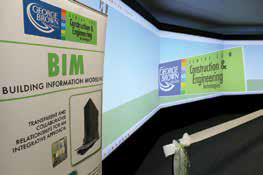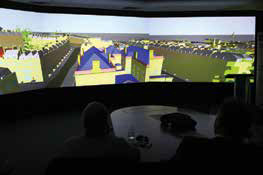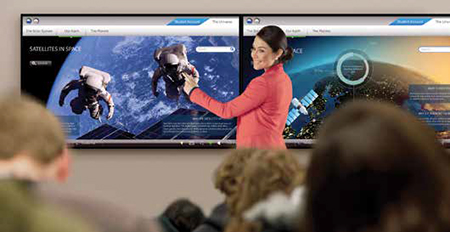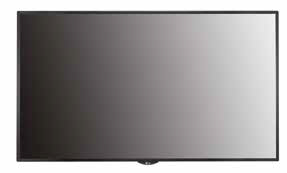6 Ways Tech Managers Can Save on Displays


Featured: Christie MicroTiles at Hunt Library at North Carolina State University.
Photo credit: Hunt Library/North Carolina State University. The cost of video displays has indeed come down over the last few years, but they still come at a price. For technology managers working in commercial markets, such as offices and higher ed, the pressure to get the most bang for the buck is very real: budgeting structures can be less flexible than they are in the corporate world, and recycle periods are often longer.
While the concept of future-proofing, in tech at least, is more fantasy than reality, there are a few ways to ensure that the equipment you purchase serves your needs for as long as possible. And in many cases, the choices you make will have little to do with the displays themselves.
First off, as with any tech deployment, defining use cases is crucial—and this means actually listening to the end user. “It’s very easy to cut corners to save money up front and get products that do most of what’s specified, but don’t meet all your needs,” warns Curtis Lingard, product manager at display solutions manufacturer Christie. “This could potentially mean the technology isn’t used at all, so the money you spent was wasted.”
Lingard also notes that separate budgets for purchasing and maintenance presents some challenges. Flat panels, or laser-based or LED projectors, for example, incur few if any maintenance costs—there is no need to replace lamps and filters—however the cash outlay for them is higher up front. For this reason, Lingard urges higher education facilities to merge the two into one budget that accounts for the total cost of ownership. “This allows you to invest more up front on better equipment, but with a lower [total cost of ownership] rather than a product costing less up front, but with ongoing maintenance or consumable parts eventually costing you more in the long run,” he explained.



George Brown College in Toronto, Canada Dana Corey, vice president of global sales at Prysm, maker of video walls and collaboration technology, argues that the best approach is to consider the entire integrated system, which includes infrastructure. “By infrastructure, I mean the amount of power that’s required to run the display, and the amount of HVAC that needs to be driven to the room to cool the display or dissipate the heat so that it’s comfortable for the users in the room,” he said. When people are comfortable, he adds, tech managers receive fewer complaints—and spend fewer resources answering support and maintenance calls.
When planning a purchase, here are some ways that you can get the most out of your display dollars:
HUDDLE UP AND SAVE
A daily selection of features, industry news, and analysis for tech managers. Sign up below.
Because they’re smaller, huddle room displays aren’t as expensive, and the nature of deployments—which, if planned well, are faster than they are in larger spaces— helps both equipment and installation control costs. Lingard also notes that when schools deploy in a number of huddle rooms at the same time, they may be able to benefit from bulk purchases.


EMBEDDING THE (PREVIOUSLY) EXTERNAL . . .
Several manufacturers are offering displays with embedded components, such as media players and content management platforms. LG’s system-on-achip webOS for signage platform is just one example of a solution that eliminates the need for an external media player, and enables operators to manage systems remotely.
With its Smart Signage Platform, Samsung also embeds the media player into its displays. “It eliminates the black box behind the screen, so there is one less device, now, to maintain, and it helps simplify that deployment and maintenance going forward,” said Michael O’Halloran, product marketing manager for Smart Signage at Samsung Electronics America. “When you eliminate a device, there’s an incredible trickle-down of cost savings that goes with it.” The manufacturer has also begun adding Wi-Fi connectivity to its displays as well.

… AND EMBEDDING THE FUTURE
Devan Cress, director of sales in the Broadcast AV Division at Marshall Electronics, advises tech managers to consider systems that are embedded with new technologies in an effort to boost the longevity of the display. “I have seen institutions purchase composite monitors because that is what was available at the time, however the better solution would have been to purchase an HD monitor that was capable of supporting composite,” Cress illustrated. “In this manner you could upgrade to HD without tossing out your old display.” While he admits that no solution is future-proof, this approach “will provide some good measure of protection against purchasing a product that runs the risk of becoming obsolete.”

CLEVER CABLING AND CONNECTIVITY
A number of technologies, such as HDBaseT, DVI extenders, and encoded video, like H.264, allow video to be distributed over network video, simplifying cabling. “This lets you run network cable—typically Category 6—between the location of the display device and the source location, and then choose the delivery method or even change it later,” Lingard noted.
“The thing we focus our attention on when we are talking with our clients about display applications is to provision good network connectivity to the end-display device,” said Colin Farquhar, CEO at the enterprise IPTV distribution and management solutions developer, Exterity. This could mean fixed connections, or Wi-Fi, or both. He argues that this is especially important because an increasing number of displays incorporate IP connectivity. “The display is becoming less of a passive device and more of an active, smart device. You then need some level of control infrastructure in place so that you can direct the display to access whatever services might be necessary for that teaching environment.”
INVEST IN SOFTWARE, SAVE ON HARDWARE
“Whatever you’re putting on the screen itself is directly related to the actual software that’s driving that content,” said Neal Caminsky, director of product management at platform developer X2O Media. Tech managers can reap cost savings by making careful choices when investing in software. “Certain software will give you the ability to drive more than one screen from a single PC or a single player, versus other software that might be a turnkey solution that can only drive one monitor.” When the software will manage multiple screens from one PC, facilities can save on licensing costs, computers, and cabling.

A WORD ON 4K AND 8K: KNOW YOUR WORKFLOW
If you want to buy right the first time, it’s important to have a clear understanding of the full workflow of your 4K and 8K content, depending on the application. “It’s very frustrating to buy a display you think will be compatible with the sources you will use, only to find out the format or connectivity needed varies from what you purchased, and you need to buy another display,” Lingard warns, adding that not all 4K and 8K products are created equal. “Make sure to find out the details of what kind of 4K or 8K is needed before buying.”
When it comes to resolution, Farquhar encourages tech managers to first consider the application— once again, the use case dictates all. Students studying medicine, for example, may benefit from the highest-definition, while English majors may not need the ultra-resolution pixels. “That type of thing is very application- dependent. It makes the challenge for the tech manager much, much greater because they have to look not just at the display technology in a very general fashion, but also at the category of the application,” he said. “Some of those investments will be five, 10-year investments, others will be investments [for] a couple of years, depending on the actual use of the product.”
Freelance writer/editor Carolyn Heinze is a regular contributor to AV Technology, Systems Contractor News, and Sound & Video Contractor.
Info
CHRISTIE
www.christiedigital.com
EXTERITY
www.exterity.com
LG
www.lg-one.com
MARSHAL ELECTRONICS
www.marshalldigitalsignage.com
PRYSM
www.prysm.com
SAMSUNG
www.samsung.com
X2O MEDIA
www.x2omedia.com
Carolyn Heinze has covered everything from AV/IT and business to cowboys and cowgirls ... and the horses they love. She was the Paris contributing editor for the pan-European site Running in Heels, providing news and views on fashion, culture, and the arts for her column, “France in Your Pants.” She has also contributed critiques of foreign cinema and French politics for the politico-literary site, The New Vulgate.
